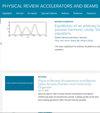Calculations of safe collimator settings and β * at the CERN Large Hadron Collider
Physical Review Special Topics-accelerators and Beams
Pub Date : 2015-06-22
DOI:10.1103/PHYSREVSTAB.18.061001
引用次数: 44
Abstract
The first run of the Large Hadron Collider (LHC) at CERN was very successful and resulted in important physics discoveries. One way of increasing the luminosity in a collider, which gave a very significant contribution to the LHC performance in the first run and can be used even if the beam intensity cannot be increased, is to decrease the transverse beam size at the interaction points by reducing the optical function β . However, when doing so, the beam becomes larger in the final focusing system, which could expose its aperture to beam losses. For the LHC, which is designed to store beams with a total energy of 362 MJ, this is critical, since the loss of even a small fraction of the beam could cause a magnet quench or even damage. Therefore, the machine aperture has to be protected by the collimation system. The settings of the collimators constrain the maximum beam size that can be tolerated and therefore impose a lower limit on β . In this paper, we present calculations to determine safe collimator settings and the resulting limit on β , based on available aperture and operational stability of the machine. Our model was used to determine the LHC configurations in 2011 and 2012 and it was found that β could be decreased significantly compared to the conservative model used in 2010. The gain in luminosity resulting from the decreased margins between collimators was more than a factor 2, and a further contribution from the use of realistic aperture estimates based on measurements was almost as large. This has played an essential role in the rapid and successful accumulation of experimental data in the LHC.欧洲核子研究中心大型强子对撞机安全准直器设置和β *的计算
欧洲核子研究中心的大型强子对撞机(LHC)的首次运行非常成功,并产生了重要的物理发现。增加对撞机亮度的一种方法是通过减小光学函数β来减小相互作用点处的横向光束尺寸,这种方法在首次运行时对LHC的性能做出了非常重要的贡献,即使不能增加光束强度也可以使用。然而,当这样做时,光束在最终聚焦系统中变得更大,这可能使其孔径暴露于光束损失。对于设计用于存储总能量为362兆焦耳的光束的大型强子对撞机来说,这是至关重要的,因为即使光束的一小部分损失也可能导致磁铁猝灭甚至损坏。因此,机器孔径必须有准直系统的保护。准直器的设置限制了可以容忍的最大光束尺寸,因此对β施加了一个下限。在本文中,我们给出了计算来确定安全准直器设置和由此产生的β限制,基于可用孔径和机器的运行稳定性。我们的模型在2011年和2012年用于确定LHC的组态,发现与2010年使用的保守模型相比,β可以显著降低。准直器之间的间隙减小所产生的亮度增益超过了2倍,而基于测量的实际孔径估计的使用所产生的进一步贡献几乎同样大。这对大型强子对撞机实验数据的快速和成功积累起了至关重要的作用。
本文章由计算机程序翻译,如有差异,请以英文原文为准。
求助全文
约1分钟内获得全文
求助全文
来源期刊
自引率
0.00%
发文量
0
审稿时长
3-8 weeks
期刊介绍:
Physical Review Special Topics - Accelerators and Beams (PRST-AB), is a peer reviewed, purely electronic journal, distributed without charge to readers and funded by contributions from national laboratories. It covers the full range of accelerator science and technology: subsystem and component technologies, beam dynamics; accelerator applications; and design, operation, and improvement of accelerators used in science and industry. This includes accelerators for high-energy and nuclear physics, synchrotron radiation production, spallation neutron sources, medical therapy, and intense beam applications.

 求助内容:
求助内容: 应助结果提醒方式:
应助结果提醒方式:


